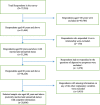Association between physical limitations and depressive symptoms among Indian elderly: marital status as a moderator
- PMID: 34781925
- PMCID: PMC8594119
- DOI: 10.1186/s12888-021-03587-3
Association between physical limitations and depressive symptoms among Indian elderly: marital status as a moderator
Abstract
Background: Depression among the elderly is well-documented and associated with socio-economic factors, physical and mental health conditions. Few studies have focused on older adults' physical limitations and depressive symptoms. However, very little is known about marital status' role in such associations, especially in India. The present study examines the association between physical limitations and self-reported depressive symptoms and moderating role of marital status in such association separately for men and women.
Methods: The present study used data from the Longitudinal Ageing Study in India (LASI) wave 1, 2017-2018, a nationally and state representative longitudinal large-scale survey of ageing and health. For the present research, a total sample of 20,806 older adults aged 60+ years was selected after excluding missing values. Along with descriptive statistics, binary logistic regression analysis and interaction effect of marital status were applied to examine the association between physical limitations (functional limitations and mobility difficulty) with the depressive symptoms separately for men and women.
Results: About 58, 50, and 45% elderly reported having depressive symptoms and had difficulty in 2+ ADLs, 2+ IADLs, and 2+ mobility difficulties, respectively. By the marital status, the prevalence of depressive symptoms was higher among currently unmarried than currently married, irrespective of type and number of physical limitations. The unadjusted, marital and multivariate-adjusted association suggested that elderly with more than two ADLs, IADLs, and mobility difficulty had higher odds of depressive symptoms. The gender stratified interaction effect of marital status and physical limitations on depressive symptoms indicated that currently unmarried elderly, particularly unmarried older women with 2+ ADLs (OR = 2.85; CI 95% = 1.88-3.09), 2+ IADLs (OR = 2.01; CI 95% = 1.74-2.31) and 2+ mobility difficulty (OR = 2.20; CI 95% = 1.86-2.60) had higher odds of depressive symptoms. However, such association was only valid for unmarried men having mobility difficulty.
Conclusion: The study highlights that the elderly with physical limitations such as ADLs, IADLs, and mobility difficulty require attention and care. Although married elderly are less likely to have depressive symptoms even with all the mentioned physical limitations, unmarried women are more vulnerable to have depressive symptoms with physical limitations.
Keywords: ADLs; Elderly depressive symptoms; IADLs; Marital status; Mobility difficulty; Physical limitations.
© 2021. The Author(s).
Conflict of interest statement
All authors declare no potential competing interests.
Figures



Similar articles
-
Rural urban differences in self-rated health among older adults: examining the role of marital status and living arrangements.BMC Public Health. 2022 Nov 25;22(1):2175. doi: 10.1186/s12889-022-14569-9. BMC Public Health. 2022. PMID: 36434537 Free PMC article.
-
Adverse childhood experiences, marital status and depressive symptoms in later life among the Chinese middle-aged and older adults : the mediating role of marital status.BMC Public Health. 2024 Aug 19;24(1):2246. doi: 10.1186/s12889-024-19787-x. BMC Public Health. 2024. PMID: 39160540 Free PMC article.
-
The association of widowhood and living alone with depression among older adults in India.Sci Rep. 2021 Nov 4;11(1):21641. doi: 10.1038/s41598-021-01238-x. Sci Rep. 2021. PMID: 34737402 Free PMC article.
-
Association between poor self-reported health and unmarried status among adults: examining the hypothesis of marriage protection and marriage selection in the Indian context.BMC Public Health. 2022 Sep 22;22(1):1797. doi: 10.1186/s12889-022-14170-0. BMC Public Health. 2022. PMID: 36138371 Free PMC article.
-
Social support moderates the association of functional difficulty with major depression among community-dwelling older adults: evidence from LASI, 2017-18.BMC Psychiatry. 2022 May 4;22(1):317. doi: 10.1186/s12888-022-03959-3. BMC Psychiatry. 2022. PMID: 35509005 Free PMC article.
Cited by
-
The association between functional status and physical pain with depressive symptoms after a stroke event: A cross-sectional analysis of the China Health and Retirement Longitudinal Study 2018.Front Psychiatry. 2022 Sep 12;13:927856. doi: 10.3389/fpsyt.2022.927856. eCollection 2022. Front Psychiatry. 2022. PMID: 36172512 Free PMC article.
-
How migration and its types affect mental health in later life: a cross-sectional study among the older adults in India.BMC Psychiatry. 2025 May 1;25(1):446. doi: 10.1186/s12888-025-06891-4. BMC Psychiatry. 2025. PMID: 40312310 Free PMC article.
-
Exercise effects on symptoms of depression and anxiety vary by patient, clinical, and intervention characteristics in cancer survivors: Results from pooled analyses of individual participant data of 26 RCTs.Support Care Cancer. 2025 Jul 1;33(7):647. doi: 10.1007/s00520-025-09646-9. Support Care Cancer. 2025. PMID: 40591016 Free PMC article.
-
Rural urban differences in self-rated health among older adults: examining the role of marital status and living arrangements.BMC Public Health. 2022 Nov 25;22(1):2175. doi: 10.1186/s12889-022-14569-9. BMC Public Health. 2022. PMID: 36434537 Free PMC article.
-
Social exclusion and mental health among older adults: cross-sectional evidence from a population-based survey in India.BMC Psychiatry. 2022 Jun 18;22(1):409. doi: 10.1186/s12888-022-04064-1. BMC Psychiatry. 2022. PMID: 35717142 Free PMC article.
References
-
- Djernes JK. Prevalence and predictors of depression in populations of elderly: a review. Acta Psychiatr Scand. 2006;113(5):372–87. 10.1111/j.1600-0447.2006.00770.x. - PubMed
-
- Katrona CL. Depression in old age. New York: Wiley; 1994.
-
- Williamson GM, Schulz R. Symptoms of depression in elderly persons: beyond the effects of physical illness and disability. In: Vellas BJ, Albarede JL, editors. Facts and research in gerontology journal. New York: Springer; 1995. pp. 9–19.
MeSH terms
LinkOut - more resources
Full Text Sources
Medical

